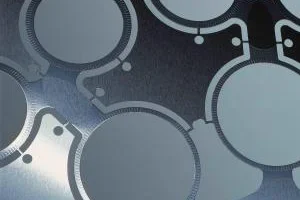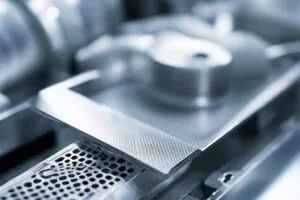When working with precision metal components, many learn that no single fabrication process fits every challenge.
When tolerances are tight, features are fine, and materials are thin or complex shapes, traditional methods like stamping, punching, or laser and EDM cutting can introduce limitations—mechanical stress, heat distortion, or tooling costs among them. That’s where Photo Chemical Machining (PCM) stands apart.
Here are six times to consider Photo Etching (PCM by another name):
1. When the Design Features Are Extremely Fine or Complex
PCM is a photolithographic process capable of producing intricate profiles, micro features, and complex geometries that would be difficult or impossible to machine or stamp.
• No mechanical stress: There’s no contact with cutting tools or dies.
• True-to-design accuracy: Etched features replicate the CAD image exactly, ideal for fine meshes, filters, and precision spring elements.
• Consistent edge definition: Even on complex or compound shapes.
Typical features can be as fine as 0.1 mm (0.004 in), with tolerances down to ±0.38 mm depending on thickness.
2. When Material Integrity Must Be Preserved
Laser, plasma, and EDM cutting introduce heat-affected zones (HAZ), which can alter metallurgical properties, cause edge hardening, or induce microcracks—issues that are especially critical in aerospace alloys, battery foils, or precision electronic components.
PCM is a cold process, removing metal chemically rather than thermally. The result:
• No burrs or recast layers.
• No stress, deformation, or surface hardening.
• Uniform material properties across every part.
3. When Prototyping or Design Iteration Is Frequent
Because PCM uses photo tooling instead of hard dies, design changes are quick and inexpensive to implement. New patterns can be generated digitally and applied without investing in costly stamping tools or EDM fixturing.
• Perfect for rapid prototyping or short runs.
• Seamless transition to full production without retooling delays.
This flexibility makes PCM especially valuable for R&D programs and for industries under constant innovation pressure—electronics, medical devices, and fuel cell technologies among them.
4. When Production Volumes Are Moderate to High, but Tooling Budgets Are Tight
Unlike stamping or punching, PCM requires no expensive, wear-prone dies. Phototools are and inexpensive to reproduce or modify, generally less than $500.
This not only reduces upfront cost but also eliminates tool wear variables that affect dimensional consistency over long runs.
5. When Edge Quality and Burr-Free Surfaces Matter
Mechanical or thermal cutting processes often require secondary finishing to remove burrs, slag, or taper.
PCM produces parts that are flat, burr-free, and ready for assembly or plating straight from the etching line. This is particularly beneficial in multi-layer laminations, fine filters, and components where post-processing could distort thin materials.
6. When Working with Thin or Delicate Metals
Photo chemical machining excels in thin gauge metals (typically 0.001–0.080 inch thick). Stamping or punching thin foils risks distortion or tearing, while lasers can warp small parts through heat input.
PCM maintains flatness and feature fidelity even in materials like stainless steel, copper, nickel and specialty alloys.
In Summary
If your part design demands:
• Intricate detail
• No burrs or heat distortion
• Economical prototyping and fast design iteration
• Consistent quality across high volumes
…then Photo Chemical Machining may be the most efficient and precise solution available.
By integrating PCM early in the design phase, engineers can unlock geometries and tolerances that conventional processes simply can’t match—without sacrificing time, cost, or material performance.
CONARD’s Free Ebook Design Guide can be Downloaded here:
Comprehensive Guide to Photochemical Machining
"*" indicates required fields



